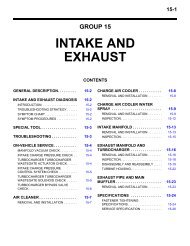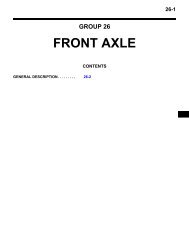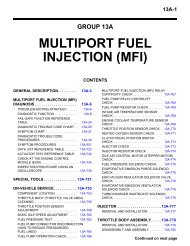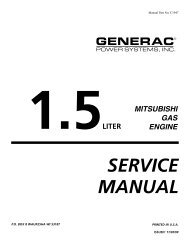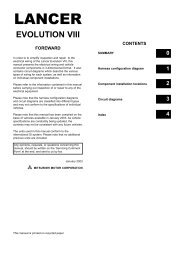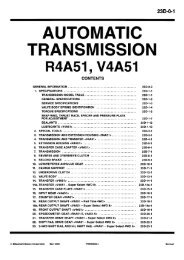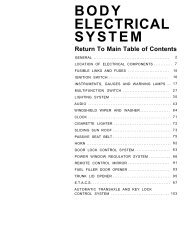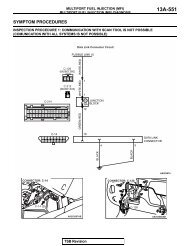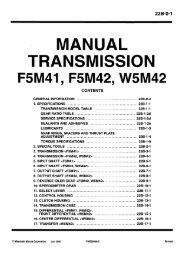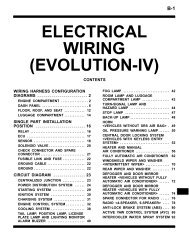You also want an ePaper? Increase the reach of your titles
YUMPU automatically turns print PDFs into web optimized ePapers that Google loves.
EMISSION<br />
CONTROL<br />
SYSTEM<br />
Return to Main Table of Contents<br />
GENERAL ................................................................ 2<br />
CRANKCASE EMISSION SYSTEM ................................... 9<br />
EVAPORATIVE EMISSION SYSTEM ............................ 10<br />
EXHAUST EMISSION SYSTEM .................................. 14
29-2 GENERAL<br />
GENERAL<br />
SPECIFICATIONS<br />
Components Function Remarks<br />
Crankcase <strong>Emission</strong> <strong>Control</strong> <strong>System</strong><br />
Positive crankcase ventilation (PCV) valve<br />
Evaporative <strong>Emission</strong> <strong>Control</strong> <strong>System</strong><br />
EVAP Canister<br />
EVAP Canister Purge Solenoid Valve<br />
Exhaust <strong>Emission</strong> <strong>Control</strong> <strong>System</strong><br />
MFI system (air-fuel mixture control device)<br />
Three-way catalytic converter<br />
Exhaust gas recirculation system<br />
EGR valve<br />
EGR TVV (Except California)<br />
HC reduction<br />
HC reduction<br />
CO, HC, NOx reduction<br />
CO, HC, NOx reduction<br />
NOx reduction<br />
Variable flow rate type<br />
ON/OFF solenoid valve<br />
Oxygen sensor feedback type<br />
Monolith type<br />
Single type<br />
Bimetal type<br />
EGR TVV : Exhaust Gas Recirculation Thermal Vacuum Valve<br />
EVAP : Evaporative <strong>Emission</strong><br />
MFI : Multiport Fuel Injection<br />
SERVICE STANDARD<br />
EVAP Canister Purge Solenoid Valve<br />
Coil resistance<br />
EGR TVV temperature<br />
Opening temperature<br />
Closing temperature<br />
EGR temperature sensor (California only)<br />
Coil resistance<br />
EGR solenoid valve (California only)<br />
Coil resistance<br />
36-44 [at 20°C (68 o F)]<br />
MIN.50°C(122 o F)<br />
61-69 o C (142-156°F)<br />
60-83 [at 50°C (122 o F)]<br />
11-14 [at100°C(212 o F)]<br />
36-44 [at 20°C (68 o F)]<br />
TIGHTENING TORQUE<br />
Nm kg.cm Ib.ft<br />
Positive crankcase ventilation valve 8-12 80-120 6-8<br />
EGR valve installation bolt 15-22 150-220 11-16<br />
EGR TVV 20-40 200-400 14-29<br />
EGR temperature sensor 10-12 100-120 7-9<br />
SEALANT<br />
EGR TVV thread portion<br />
Three bond 1104 or equivalent
GENERAL 29-3<br />
TROUBLESHOOTING<br />
Symptom<br />
Engine will not start or hard<br />
to start<br />
Rough idle or engine stalls<br />
- Engine hesitates or poor<br />
acceleration<br />
Excessive oil consumption<br />
Poor fuel mileage<br />
Probable cause<br />
Vacuum hose disconnected or damaged<br />
The EGR valve is not closed<br />
Malfunction of the EVAP Canister Purge<br />
Solenoid Valve<br />
The EGR valve is not closed<br />
Vacuum hose disconnected or damaged<br />
Malfunction of the PCV valve<br />
Malfunction of the EVAP Canister Purge<br />
system<br />
Malfunction of the exhaust gas recirculation<br />
system<br />
Positive crankcase ventilation line<br />
clogged<br />
Malfunction of the exhaust gas recirculation<br />
system<br />
Remedy<br />
Repair or replace<br />
Repair or replace<br />
Repair or replace<br />
Repair or replace<br />
Repair or replace<br />
Replace<br />
Check the system; if there is a<br />
problem, check its component parts<br />
Check the system; if there is a problem,<br />
check its component parts<br />
Check positive crankcase ventilation<br />
system<br />
Check the system; if there is a<br />
problem, check its component parts
29-4 GENERAL<br />
EMISSION CONTROLS LOCATION<br />
A. PCV valve<br />
B. EVAP Canister Purge Selenoid Valve<br />
C. EGR selenoid valve (California only)<br />
D. EGR valve<br />
E. EGR temperature sensor (California only)<br />
F. EGR TVV<br />
G. EVAP Canister<br />
H. Catalytic converter<br />
I. Two-way valve
escan 29-5; upside down
29-6<br />
VACUUM HOSES LAYOUT<br />
[Except California]<br />
Canister<br />
B : Black<br />
[California only]<br />
Vehicle front<br />
G : Green<br />
Y : Yellow<br />
L : Light Blue<br />
R : Red<br />
B : Black
SCHEMATIC DRAWING (Except California)<br />
GENERAL 29-7<br />
*1 HEATED OXYGEN SENSOR<br />
*2 VOLUME AIR FLOW SENSOR<br />
*3 INTAKE AIR TEMP. SENSOR<br />
*4 ‘THROTTLE POSITION SENSOR<br />
*5 IDLE SWITCH<br />
*6 CAMSHAFT POSITION SENSOR<br />
*7 CRANKSHAFT POSITION SENSOR<br />
*6 BAROMETRIC PRESSURE SENSOR<br />
*9 EGR TEMP. SENSOR<br />
*10 ENGINE COOLANT TEMP. SENSOR<br />
o STARTER “S” TERMINAL<br />
o BATTERY VOLTAGE<br />
o VEHICLE SPEED SENSOR<br />
o COOLER LOAD SIGNAL<br />
o “N” SWITCH (A/T ONLY)<br />
o POWER STEERING SWITCH<br />
o CRANKING SIGNAL<br />
o FUEL PUMP CONTROL<br />
o CONTROL RELAY<br />
o COOLER RELAY<br />
o IGNITION TIMING CONTROL<br />
o DIAGNOSIS<br />
TWC : Three Way Catalytic Converter
29-8 GENERAL<br />
SCHEMATIC DRAWING (California only)<br />
*1 HEATED OXYGEN SENSOR (FR, RR;<br />
*2 VOLUME AIR FLOW SENSOR<br />
*3 INTAKE AIR TEMP. SENSOR<br />
*4 THROTTLE POSITION SENSOR<br />
*5 CAMSHAFT POSITION SENSOR<br />
*6 CRANKSHAFT POSITION SENSOR<br />
*7 BAROMETRIC PRESSURE SENSOR<br />
*6 EGR TEMP. SENSOR<br />
*9 ENGINE COOLANT TEMP. SENSOR<br />
*10 IDLE SWITCH<br />
o STARTER “S” TERMINAL<br />
o BATTERY VOLTAGE<br />
o VEHICLE SPEED SENSOR<br />
o COOLER LOAD SIGNAL<br />
o “N” SWITCH (A/T ONLY)<br />
o POWER STEERING SWITCH<br />
*1 INJECTOR<br />
*2 IGNITION COIL<br />
*3 ISC MOTOR<br />
*4 EVAP CANISTER PURGE<br />
SOLENOID VALVE<br />
*5 EGR SOLENOID VALVE<br />
o FUEL PUMP CONTROL<br />
(CONTROL RELAY)<br />
o COOLER RELAY<br />
o IGNITION TIMING CONTROL<br />
o DIAGNOSIS<br />
TWC : Three Way Catalytic Converter
CRANKCASE EMISSION SYSTEM<br />
1. Disconnect the ventilation hose from the positive crankcase<br />
ventilation (PCV) valve. Remove the PCV valve from the rocker<br />
cover and reconnect it to the ventilation hose.<br />
2. Run the engine at idle and put a finger on the open end of the<br />
PCV valve and make sure that intake manifold vacuum is felt.<br />
NOTE<br />
The plunger inside the PCV valve will move back and<br />
forth.<br />
CRANKCASE EMISSION SYSTEM 29-9<br />
3. If vacuum is not felt, clean the PCV valve and ventilation hose<br />
in cleaning solvent or replace if necessary.<br />
INSPECTION<br />
1. Remove the positive crankcase ventilation valve.<br />
2. Insert a thin stick into the positive crankcase ventilation valve<br />
from the threaded side to check that the plunger moves.<br />
3. If the plunger does not move, the positive crankcase ventilation<br />
valve is clogged. Clean it or replace.<br />
INSTALLATION<br />
Install the positive crankcase ventilation valve and tighten to the<br />
specified torque.<br />
PCV valve tightening torque .............<br />
8-12Nm(80-120kg.cm,6-8Ib.ft)
29-10 EVAPORATIVE EMISSION SYSTEM<br />
EVAPORATIVE EMISSION SYSTEM<br />
COMPONENTS<br />
EVAP : Evaporative <strong>Emission</strong><br />
EVAP CANISTER<br />
Inspection<br />
1. Look for loose connections, sharp bends or damage to the fuel<br />
vapor lines.<br />
2. Look for distortion, cracks or fuel leakage.<br />
3. After removing the EVAP Canister, inspect for cracks or<br />
damage.
EVAP CANISTER PURGE SOLENOID VALVE<br />
Inspection<br />
EVAPORATIVE EMISSION CONTROL SYSTEM 29-11<br />
NOTE<br />
When disconnecting the vacuum hose, make an identification<br />
mark on it so that it can be reconnected to its original position.<br />
1. Disconnect the vacuum hose (black with red stripe) from the<br />
solenoid valve.<br />
2. Detach the harness connector.<br />
3. Connect a vacuum pump to the nipple to which the red-striped<br />
vacuum hose was connected.<br />
4. Apply vacuum and check when voltage is applied to the purgecontrol<br />
solenoid valve and when the voltage is discontinued.<br />
Battery voltage I Normal condition<br />
When applied<br />
When discontinued<br />
Vacuum is released.<br />
Vacuum is maintained<br />
5. Measure the resistance between the terminals of the solenoid<br />
valve.<br />
EVAP Canister Purge Solenoid Valve<br />
Coil resistance ................................. 36-44<br />
[at 20°C(68 o F)]<br />
OVERFILL LIMITER (TWO-WAY VALVE)<br />
To inspect the overfill limiter (Two-way valve), refer to Group 31-<br />
Fuel tank.<br />
FUEL FILLER CAP<br />
Check the gasket of the fuel filler cap, and the filler cap itself, for<br />
damage or deformation; replace the cap if necessary.
29-12 EVAPORATIVE EMISSION SYSTEM<br />
CHECKING PURGE SYSTEM<br />
Checking<br />
1. Disconnect the vacuum hose (red stripe) from the throttle body,<br />
and connect a vacuum pump to the vacuum hose.<br />
2. Check the following points when the engine is cold [engine<br />
coolant temperature 60°C (140°F) or below] and when it is warm<br />
[engine coolant temperature 70°C (158°F) or higher].<br />
When engine is cold<br />
Engine operating<br />
condition<br />
Applying vacuum<br />
Result<br />
Idling<br />
3,000rpm<br />
50 kPa (7.3 psi) Vacuum is held
EVAPORATIVE EMISSION SYSTEM 29-13<br />
When engine is warm<br />
Engine operating<br />
condition<br />
Aply vacuum<br />
Result<br />
Idling I 50 kPa (7.3 psi) I Vacuum is held<br />
Within 3 minutes Try to apply Vacuum is released<br />
after engine start vacuum<br />
3,000 rpm<br />
After 3 minutes<br />
have passed after<br />
engine start<br />
3,000 rpm<br />
50 kPa (7.3 psi) Vacuum will be held<br />
momentarily, after<br />
which, it will be<br />
released.<br />
NOTE<br />
The vacuum will leak<br />
continuously if the<br />
altitude is 2,200 m<br />
(7,200 ft.) or higher,<br />
or the intake air<br />
temperature is 50°C<br />
(122°F) or lower.<br />
PURGE PORT VACUUM<br />
Inspection<br />
Engine coolant temperature: 80-95 o C (176-205°F)<br />
1. Disconnect the vacuum hose from the intake manifold purge<br />
hose nipple and connect a hand vacuum pump to the nipple.<br />
2. Start the engine and check to see that, after raising the engine<br />
speed by racing the engine, vacuum remains fairly constant.<br />
NOTE<br />
If there is no vacuum created, it is possible that the intake<br />
manifold port may be clogged and require cleaning.
29-14 EXHAUST EMISSION SYSTEM<br />
EXHAUST EMISSION SYSTEM<br />
Exhaust emissions (CO, HC, NOx) are controlled by a combination<br />
of engine modifications and the addition of special control components.<br />
Modifications to the combustion chamber, intake manifold, camshaft<br />
and ignition system form the basic control system. Additional<br />
control devices include an exhaust gas recirculation (EGR) system<br />
and catalytic converters.<br />
These systems have been integrated into a highly effective system<br />
which controls exhaust emissions while maintaining good driveability<br />
and fuel economy.<br />
AIR/FUEL MIXTURE RATIO CONTROL SYSTEM<br />
[Multport Fuel Injection (MFI) <strong>System</strong>]<br />
The MFI system is a system which employs the signals from the<br />
oxygen sensor to activate and control the injector installed in the<br />
manifold for each cylinder, thus precisely regulating the air/fuel<br />
mixture ratio and reducing emissions.<br />
This in turn allows the engine to produce exhaust gases of the<br />
proper composition to permit the use of a three-way catalyst. The<br />
three-way catalyst is designed to convert the three pollutants (1)<br />
hydrocarbons (HC), (2) carbon monoxide (CO), and (3) oxides of<br />
nitrogen (NOx) into harmless substances. There are two operating<br />
modes in the MFI system.<br />
1. Open-Loop air/fuel ratio is controlled by information programmed<br />
into the ECM.<br />
2. Closed-Loop air/fuel ratio is varied by the ECM based on<br />
information supplied by the oxygen sensor.
EXHAUST GAS RECIRCULATION SYSTEM<br />
Inspection (Except California)<br />
1. Disconnect the vacuum hose (green stripe) from the throttle<br />
body, and connect a vacuum pump to the vacuum hose.<br />
2. Check the following points when the engine is both cold<br />
[engine coolant temperature 50°C (122°F) or below] and hot<br />
[engine coolant temperature 80-95X (176-205°F) or higher].<br />
EXHAUST EMISSION SYSTEM 29-15<br />
Engine coolant<br />
temperature<br />
Vacuum<br />
Engine<br />
condition<br />
Cold APPLY Idling<br />
Hot<br />
6 kPa<br />
(1.7in.Hg)<br />
26 kPa<br />
(7.5 in.Hg)<br />
Idling<br />
Idle is<br />
unstable<br />
Normal<br />
condition<br />
Vacuum is<br />
released<br />
Vacuum is<br />
held<br />
Vacuum is<br />
held<br />
Inspection (California Only)<br />
1. Disconnect the vacuum hose (green stripe) from the EGR valve<br />
body, and connect a vacuum pump via the three way terminal.<br />
2. Check the following points when the engine is both cold<br />
[engine coolant temperature 20°C (68°F) or below] and hot<br />
[engine coolant temperature 70°C (158°F) or higher].<br />
[When the engine is cold]<br />
Engine condition<br />
Rev engine<br />
Normal condition<br />
No change in vacuum<br />
(atmospheric pressure)<br />
[When the engine is warm]<br />
Engine condition<br />
Rev engine<br />
Normal condition<br />
Vacuum rises temporarily to<br />
14 kPa (3.9 in.Hg) or more.<br />
3. Disconnect the three-way terminal and connect the hand vacuum<br />
pump directly to the Exhaust Gas Recirculation (EGR) valve.<br />
4. Check whether the engine stalls or the idling is unstable when a<br />
vacuum of 26 kPa (7.5 in.Hg) or higher is applied during idling.
29-16 EXHAUST EMISSION SYSTEM<br />
EGR VALVE VACUUM<br />
Inspection<br />
Engine coolant temperature: 80-95°C (176-205°F)<br />
1. Disconnect the vacuum hose from the throttle body EGR<br />
vacuum nipple and connect a hand vacuum pump to the nipple.<br />
2. Start the engine and check to see that, after raising the engine<br />
speed by racing the engine, E vacuum rises proportionately<br />
with the rise in engine speed.<br />
NOTE<br />
If there is a problem with the change in vacuum, it is<br />
possible that the throttle body E port may be clogged and<br />
require cleaning.<br />
EGR VALVE<br />
1. Remove the EGR valve and check for sticking, carbon deposits,<br />
etc.<br />
If such conditions exist, clean with solvent to ensure tight valve<br />
seat contact.<br />
2. Connect a manual vacuum pump to the EGR valve.<br />
3. Apply a vacuum of 67 kPa (9.7 psi) and check air tightness.<br />
4. Blow in air from one passage of the EGR to check condition as<br />
follows.<br />
When installing the EGR valve, use a new gasket and<br />
tighten to the specified torque.<br />
Tightening torque<br />
EGR valve .................................................<br />
15-22 Nm (150-220 kg.cm, 11-16 Ib.ft)
EXHAUST EMISSION SYSTEM<br />
29-17<br />
Exhaust Gas Recirculation Thermal Vacuum Valve<br />
[(EGR TVV) Except California]<br />
CAUTION<br />
1. Do not use a wrench on the plastic section when removing<br />
or installing the EGR TVV.<br />
2. When installing, apply a coat of sealant to the threads, and<br />
tighten to the specified torque.<br />
Tightening torque<br />
EGR TVV ........... 20-40 Nm (200-400 kg.cm, 14-29 Ib.ft)<br />
3. When disconnecting the vacuum hose, make an identification<br />
mark on it so that it can be reconnected to the original<br />
position.<br />
1. Disconnect the vacuum hoses from the EGR TVV, and connect<br />
a manual vacuum pump to the EGR TVV.<br />
2. Apply a vacuum and check the air passage through the-EGR<br />
TVV.<br />
Engine coolant temperature<br />
Normal condition<br />
50°C (122°F) or less Vacuum leaks<br />
80°C (176°F) or more Vacuum is maintained<br />
EGR Temperature Sensor (California only)<br />
1. Place the EGR temperature sensor in water, and then measure<br />
the resistance value between terminals 1 and 2 while increasing<br />
the water temperature.<br />
If out of specification, replace the EGR temperature sensor.<br />
Temperature o C ( o F)<br />
Resistance<br />
50(122) 60-83<br />
100(212) 11-14<br />
EGR <strong>Control</strong> Solenoid Valve (California only)<br />
NOTE<br />
When disconnecting the vacuum hose, make an identification<br />
mark on it so that it can be reconnected to its original position.<br />
1. Disconnect the vacuum hose (green stripe) from the solenoid<br />
valve.<br />
2. Disconnect the harness connector.<br />
3. Connect a hand vacuum pump to the nipple to which the greenstriped<br />
vacuum hose was connected.
29-18 EXHAUST EMISSION SYSTEM<br />
4. Apply a vacuum to check for a maintained vacuum when voltage<br />
applied directly to the EGR solenoid valve.<br />
When the voltage is discontinued, the vacuum is released.<br />
Battery voltage<br />
When applied<br />
When discontinued<br />
Result<br />
Vacuum is held.<br />
Vacuum is released<br />
5. Measure the resistance between the terminals of the solenoid<br />
valve.<br />
Standard value ............................... 36-44<br />
[at 20°C (68 o F)]<br />
CATALYTIC CONVERTER<br />
INSPECTION<br />
Inspect for damage, cracking or deterioration. Replace if faulty.<br />
CAUTION<br />
The catalytic converters require the use of unleaded gasoline<br />
only. Leaded gasoline will destroy the effectiveness of the<br />
catalysts as an emission control device.<br />
Under normal operating conditions, the catalytic converters<br />
will not require maintenance. However, it is important to keep<br />
the engine properly tuned. Engine misfiring may cause overheating<br />
of the catalysts. This may cause heat damage to the<br />
converters or vehicle components. The situation can also<br />
occur during diagnostic testing if any spark plug cables are<br />
removed and the engine is allowed to idle for a prolonged<br />
period of time.



